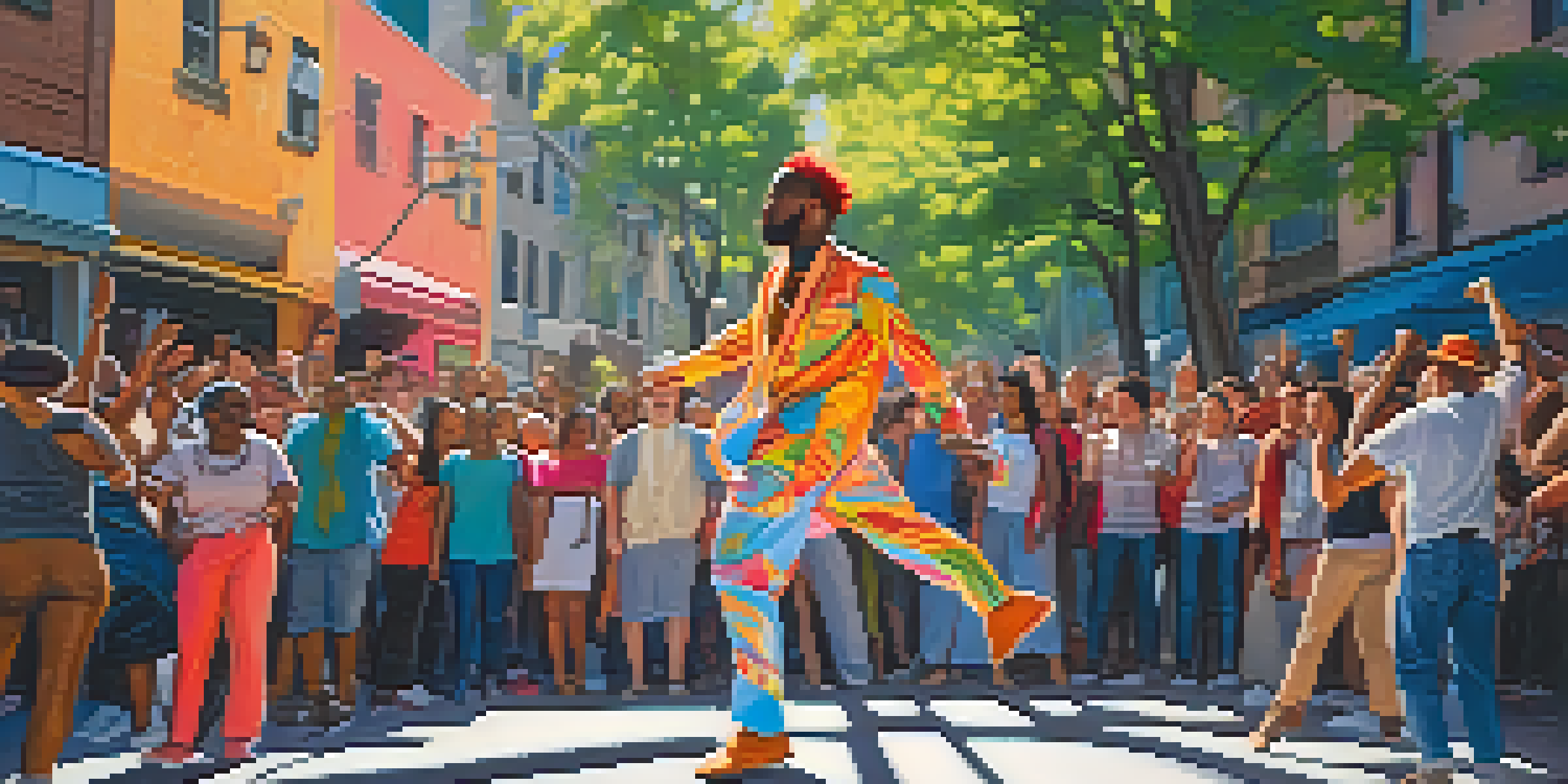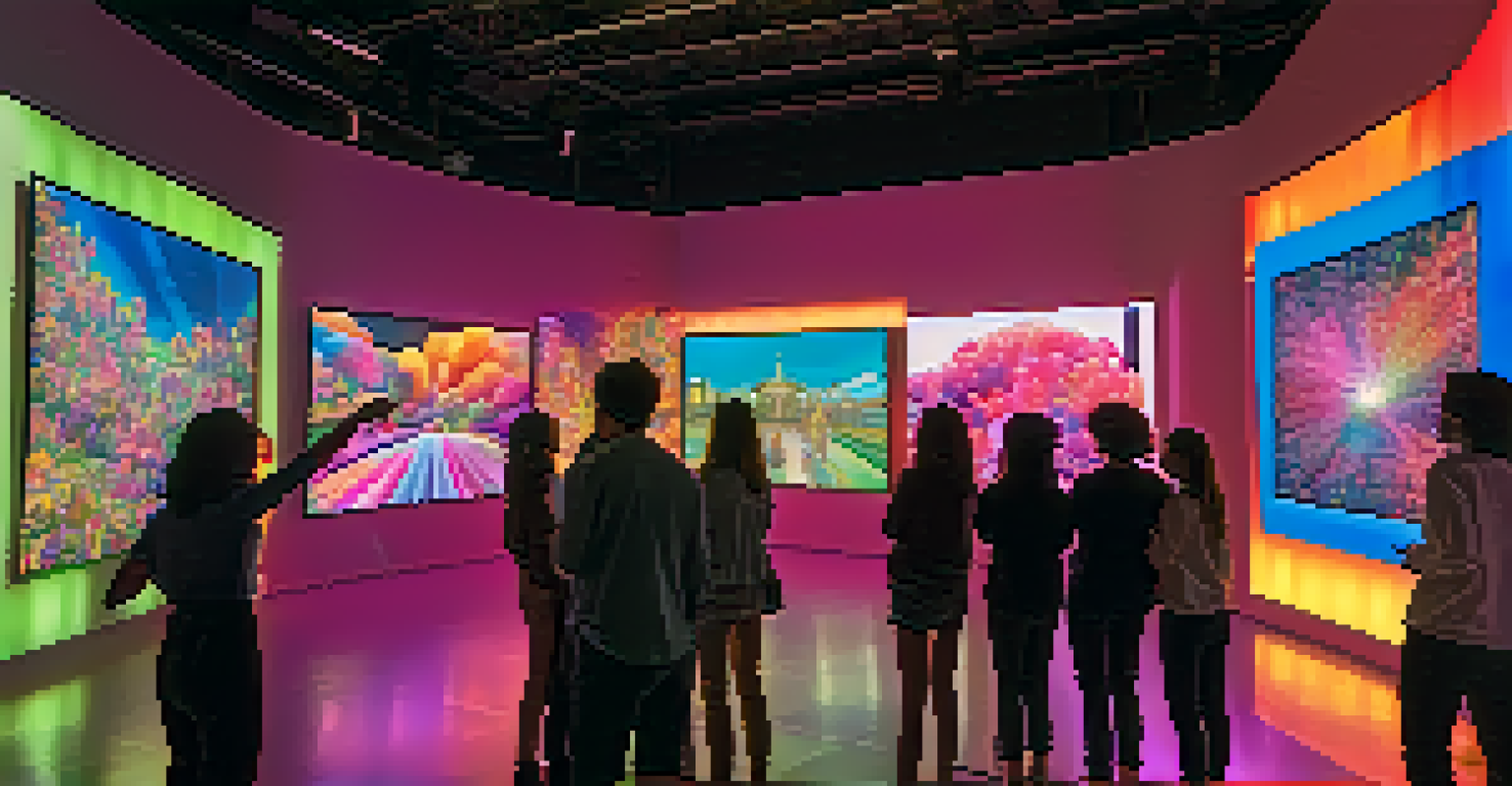The Impact of Performance Art on Viewer Engagement

Understanding Performance Art: A Unique Form of Expression
Performance art is an expressive medium that combines various art forms, including theater, dance, and visual art. It often involves live presentations that can take place in galleries, theaters, or even public spaces. Unlike traditional art, which is static and meant to be viewed, performance art is dynamic and can involve audience participation.
Performance art is a unique form of expression that can evoke emotions and foster connections between artists and audiences.
This form of art challenges the notion of what art can be, blurring the lines between the artist and the audience. By engaging viewers in real-time, performance art creates a shared experience that can evoke a wide range of emotions. This immediacy fosters a connection that is often absent in more conventional art forms.
Moreover, performance art can address critical social issues, provoking thought and conversation among audience members. This makes it not just a visual experience, but also an intellectual one, encouraging viewers to reflect on their own beliefs and feelings.
The Role of Emotion in Performance Art Engagement
One of the most powerful aspects of performance art is its ability to evoke deep emotional responses. When viewers witness a live performance, they are often swept up in the moment, feeling the artist's emotions as if they were their own. This emotional connection can lead to a more profound understanding of the themes being explored.

For example, a performance that tackles grief may resonate with individuals who have experienced loss, allowing them to process their feelings in a communal setting. The shared experience of art can foster empathy, bridging gaps between diverse audiences and creating a sense of unity.
Performance Art Creates Shared Emotions
Performance art engages audiences in real-time, fostering a communal emotional experience that enhances understanding of profound themes.
Additionally, the unpredictability of performance art adds to its emotional impact. Each performance is unique, which can heighten anticipation and engagement. Viewers may find themselves on the edge of their seats, fully invested in what unfolds before them.
Audience Participation: A Catalyst for Engagement
Many performance artists actively seek audience participation, transforming passive viewers into active participants. This can range from inviting people on stage to encouraging reactions during the performance. Such involvement blurs the line between artist and audience, creating a more immersive experience.
Art is not what you see, but what you make others see.
When audience members contribute to the performance, they become emotionally invested, often leaving a lasting impression. This participatory aspect can lead to discussions and reflections long after the performance has ended, as individuals share their experiences and interpretations with one another.
Moreover, participation can empower viewers, giving them a voice in the artistic process. This sense of agency not only increases engagement but also fosters a deeper appreciation for the art form itself.
The Impact of Context on Viewer Engagement
The context in which a performance takes place significantly influences viewer engagement. Factors such as the venue, time, and cultural setting can shape how an audience perceives and interacts with the performance. For instance, a street performance may create a more casual atmosphere, inviting spontaneous reactions from passersby.
Conversely, a performance in a formal gallery setting may encourage more introspective engagement, prompting viewers to reflect on the piece in a quieter environment. Understanding the context helps artists tailor their work to elicit the desired response from their audience.
Audience Participation Boosts Engagement
Inviting audience involvement transforms spectators into active participants, deepening their emotional investment and appreciation for the art.
In many cases, the context also informs the themes being addressed in the performance. For example, a piece performed in a community struggling with social issues may resonate differently than one presented in an affluent area. This makes the relationship between context and viewer engagement a vital consideration for performance artists.
The Evolution of Performance Art and Viewer Expectations
As society evolves, so do the expectations of audiences regarding performance art. With the rise of digital media and social platforms, viewers are increasingly accustomed to immersive and interactive experiences. This shift has influenced how performance artists create and engage with their audiences.
Today's audiences may seek not just to observe but to interact and connect with the art on a personal level. This has led to innovative approaches, such as incorporating technology into performances or creating experiences that invite real-time feedback from viewers.
As a result, performance artists are continually adapting to meet these new expectations, pushing the boundaries of traditional art forms. This evolution not only enhances viewer engagement but also expands the possibilities of what performance art can achieve.
The Role of Social Media in Enhancing Engagement
Social media plays a crucial role in amplifying the reach and impact of performance art. Artists often use platforms like Instagram, TikTok, and Facebook to share snippets of their performances, enticing viewers with a taste of the experience. This online presence can draw larger audiences to live events, enhancing engagement.
Moreover, social media allows for real-time interactions between artists and their audience. Viewers can share their thoughts, emotions, and reactions instantly, creating a dialogue that extends beyond the physical performance. This interconnectedness fosters a sense of community among fans and artists alike.
Context Shapes Viewer Engagement
The setting of a performance significantly influences how viewers perceive and connect with the art, highlighting the importance of context in engagement.
Additionally, social media serves as a platform for documentation and memory. Audiences can revisit performances through recorded clips, deepening their connection to the art and the artist. In this way, social media not only enhances engagement but also preserves the ephemeral nature of performance art.
Conclusion: The Lasting Impact of Performance Art on Viewers
In conclusion, the impact of performance art on viewer engagement is profound and multifaceted. By leveraging emotion, context, and audience participation, artists create experiences that resonate deeply with their audiences. This dynamic relationship fosters empathy, reflection, and a sense of community among viewers.
As performance art continues to evolve, so too will the ways in which it engages audiences. The integration of technology and social media is likely to further enhance this connection, allowing for even more immersive and interactive experiences.

Ultimately, performance art not only captivates viewers in the moment but also leaves a lasting impression that can influence thoughts, feelings, and conversations long after the curtain falls.